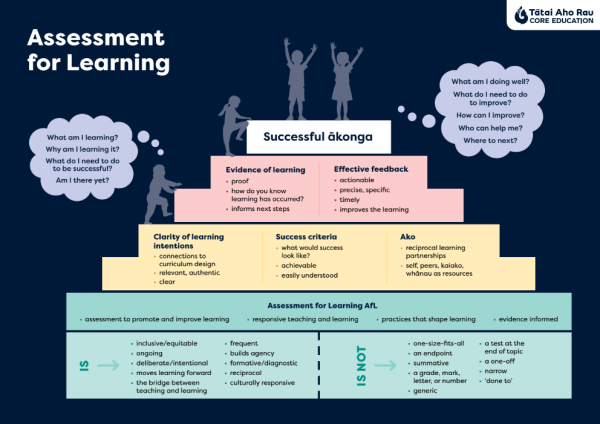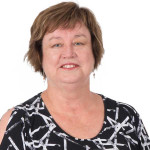Thinking critically about Assessment for Learning
When we know better we can do better!
“Do the best you can until you know better. Then, when you know better, do better.” (Maya Angelou)
This quote, paraphrased as the title of this blog, brilliantly sums up some valid advice for almost everything we do, as teachers and in life. However, its relevance here is to underpin the intent behind Assessment for Learning (AfL) for both kaiako and ākonga. To put it another way, how we can move learning forward so students become successful ‘experts’ in their learning.

The context of assessment for learning
Assessment as a term that has been used for many years in many forms and contexts: assessment of learning, assessment for learning and assessment by or as learning. The definition for Assessment for Learning | Aromatawai (AfL) used in our system focuses on what we need to consider when we support ākonga as they move their learning and achievement levels forward. It has been known in the past as diagnostic or formative assessment, and is not to be confused with Assessment OF Learning which is summative by nature, done at the end of a topic, unit of learning or piece of work, resulting in assigning a mark, grade or number. Any AfL practices we use should be done in a timely manner as part of the learning process so that the strategies we use effectively contribute towards learning progress, and justify including them in our programme. In summary:
“Assessment for learning is best described as a process by which assessment information is used by teachers to adjust their teaching strategies, and by students to adjust their learning strategies.”
The goal for all ākonga is that they become more successful in whatever task or learning goal has been shared or set as a target to aim for. As referred to in the above quote, AfL is a partnership between kaiako, ākonga, and whānau. This partnership could even potentially be between ākonga, or for ākonga to build up their own capabilities and begin to lead their own learning. When we undertake AfL activities they need to occur at a stage in learning when ākonga have both the time and the understanding to be able to act upon them, and needs to have meaning for each learner. Kaiako can then have the time and evidence in order to adapt their teaching practices if needed. Through our framework and modelling , ākonga can become active partners in the whole process. The feedback we provide needs to be delivered in a timely manner, have purpose and meaning, and be effective.
An example
I recently worked with a school to support them as they inquired into sharpening their Assessment for Learning practices. As an introductory activity I asked kaiako to imagine that they had enrolled in a class to learn to clap like an expert. In pairs, one was the learner while one became the assessor, who, without any prior discussion, asked their partner to clap for 20 seconds. The assessor then gave the learner a grade (their choice). The assessor walked away and the process was finished. Their result could have been recorded and could also have been used to generate a certificate of achievement from the Clapping Institute, if they wished. This activity triggered a lot of discussion and wondering, particularly from the perspective of the learner, as part of the debrief session that followed. How would this make you feel if you were one of those kaiako learning to clap? Would you now be an expert at clapping? How would you know? Were you asked about what you knew about clapping before you were assessed? What could you do to improve? What do you need to work on? Who or what could help you to do better? What did your rating represent? Was it the best or the worst level? What other letters were possible? Why did you need to learn to clap? Could you teach someone else how to clap with a high level of expertise?
Some ideas you could try
Understanding the learning intentions of the clapping assessment from above and having clear criteria rather than trying to guess what is in the assessor's head will enhance performance, as will having a robust feedback loop.
The following strategies could support you to become more of an expert:
- Initial conversations to gauge prior knowledge and motivation. What do you know about clapping already?
- Explore various types of clapping and the different contexts in which it occurs to deepen understanding.
- Define what constitutes good clapping visually and audibly, as well as discussing what it is not to provide clarity of outcomes.
- Clearly articulate learning intentions and success criteria rather than leaving them to assumption and a variety of individualised interpretation. What was the letter assigned all about? What does this equate to and what other letters or levels are possible? Where do I fit on the novice/expert continuum?
- Provide further opportunities for practice and assessment.
- Reflect on the purpose of received communication and understanding its implications, along with clarity on success criteria.
- Collaborative learning with peers and involvement in co-constructing assessment criteria can boost engagement and achievement.
- Finally, sharing acquired knowledge with others can solidify and reinforce understanding and skill development.
These are all aspects to consider when critically thinking about engaging in effective assessment for learning practices. As kaiako, we want to support ākonga of any age to improve their learning, using metacognitive questioning to deepen learning and understanding about successful learning and the processes behind that.
In summary, how might we critically and strategically approach AfL?
In summary, in order for our ākonga to do better, we kaiako need to know better, and we can support them in this by:
- knowing our learners - what knowledge, skills, needs and interests do they bring with them? (learner profiles or maps)
- creating clarity and being explicit about what it is they are expected to learn and why (learning intentions, objectives)
- sharing these with them, along with what success could or should look like (and maybe not look like) (success criteria)
- engaging our ākonga in the assessment for the learning process, so that they become more agentic and resilient, operating with purpose at a higher level of metacognition; and feeling more confident to effectively support others. Kaiako are not the only ones who can lead learning or assess how to move learning forward.
- eliciting evidence of learning as it happens so that we can respond more effectively if redirection, growth, extension, reteaching, further practice is required - building our evaluative capabilities
- regularly using effective feedback strategies that are specific, timely and actionable; and are proven to improve learning.
This is summarised in the diagram below:

So, if we know better, then we can do better; and so can our ākonga.
Te piko o te māhuri, tērā te tupu o te rākau.
The way in which a young sapling is nurtured determines how the tree will grow.
Assessment for learning is a Ministry of Education priority of RA PLD funding for 2024. The range of elements discussed above regarding effective Assessment for Learning (AfL) interacting and working together, building understanding using rapid cycles of teacher inquiry, is the ‘secret sauce’ of what Tātai Aho Rau brings to teacher professional learning programmes. We have a team of experienced and qualified facilitators who can work with you and your team across the current MoE priorities and in both English and Māori medium settings as you continue to enhance your pedagogical practices kete.
Enquire about professional learning with our team today, by emailing learning@core-ed.ac.nz
Further Reading:
- Absolum, M. (2006). Clarity in the Classroom. Using formative assessment. Hachette, NZ
- Clarke S, Timperley H, Hattie J. (2004). Unlocking Formative Assessment. NZ ed. Hodder Education
- TKI: Assessment for Learning. https://assessment.tki.org.nz/Assessment-for-learning/Principles-of-assessment-for-learning
- Wiliam D, Leahy S. (2015). Embedding Formative Assessment. Practical Techniques for K-12 Classrooms
